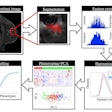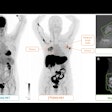
Thanks to the power of digital breast tomosynthesis (DBT), it may be possible to use observation to follow radial scars on breast images rather than surgically excise them, according to research presented Wednesday at the annual meeting of the American Roentgen Ray Society (ARRS) in Honolulu.
A team led by Dr. Ingolf Karst of Northwestern University in Chicago discovered that observation with DBT was a viable alternative to biopsy after switching to the technology from digital mammography. Karst and colleagues found that no radial scars discovered on core biopsy and followed with DBT were upgraded to invasive cancer or ductal carcinoma in situ (DCIS) on excision.
"With no upgrades to invasive cancer or DCIS found for pure radial scars, [our] results suggest it may be safe to follow-up pure radial scars diagnosed on core needle biopsy," the group wrote.
The debate over how to manage radial scars found on core needle biopsy has been marked by controversy, with breast imagers and surgeons unable to come to a consensus on which is more appropriate -- surgery or ongoing observation with mammography, Karst's group wrote.
So the researchers investigated whether the use of DBT -- thus the better visualization of findings such as architectural distortion -- would increase the detection and upgrade rates of radial scars, compared with digital mammography, and what factors might contribute to choosing surveillance over surgery.
The study included 115,430 screenings and 16,488 diagnostic mammography exams acquired over a 33-month period during which Northwestern transitioned from digital mammography to DBT. Karst's group tracked radial scars found on core needle biopsy and their upgrade rates to invasive cancer or DCIS on surgical excision in monthly increments, comparing a 12-month pretransition timeframe (December 2014 to November 2015) with a 12-month timeframe after the DBT transition (September 2016 to August 2017).
In all, 108 radial scars were identified out of a total of 115,430 screened patients. After DBT was implemented, the rate of radial scars found increased by 82.5% compared with the pretransition period; the relative upgrade rate decreased by 54.4% compared with the pretransition period. None of the 108 radial scars identified were upgraded to invasive cancer on surgical excision.
| Use of DBT for surveillance of radial scars | |||
| Before DBT (40,526 screening exams) | After DBT (44,415 screening exams) | Percent change | |
| Radial scars found | 0.08% | 0.14% | 82.5% |
| Rate of upgrade to cancer | 3.2% | 1.6% | -54.4% |
The findings offer women with radial scars an alternative to surgery and give clinicians confidence that even if radial scar detection rates increase on DBT, upgrade rates don't, and women can be safely observed with DBT, the team concluded.
"Interdisciplinary collaboration and use of our proprietary database deepened our knowledge of imaging findings and related pathology, such as architectural distortion and radial scar, and support us in management changes during times of technological shifts, such as transition from [full-field digital mammography] to DBT, to benefit our patients," Karst said in a statement released by the ARRS.




















